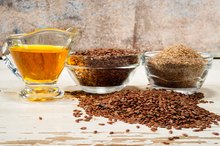Acacia Fiber Side Effects
Acacia gum, also known as arabic gum, comes from the acacia senegal tree in Africa 1. It is added to pharmaceuticals for its demulcent, or coating, properties and used medicinally in natural treatments for respiratory, digestive and skin problems. It is also added to foods for many purposes, such as to thicken, stabilize and to help oil and water mix together. However, acacia comes with some side effects, so use caution with foods containing it and talk to a doctor before using it medicinally.
Type
There are different qualities of acacia gum, dependent on the method of its extraction from the tree; the naturally obtained gum is the best quality 1. The cheaper, lower-quality gums are often sold as gum under the name Arabic. Drugs.com explains that this type is not widely classified as a food additive because its safety is not determined 1.
Known Side Effects
Is Flaxseed Oil the Same as Linseed Oil?
Learn More
Acacia is considered nontoxic when taken in food or medications. However, there are certain side effects that have resulted from taking acacia in this way or by breathing its dust. For one, acacia might increase your cholesterol levels. Also, it has caused allergic reactions in some people, such as skin lesions and respiratory concerns. When given in IV form, as was done in the past for certain medical conditions, acacia has caused damage to the liver and kidneys.
- Acacia is considered nontoxic when taken in food or medications.
- However, there are certain side effects that have resulted from taking acacia in this way or by breathing its dust.
Medication Interactions
Acacia can interact with some medications with alkaloids, and it interferes with the absorption of certain vitamins when an enzyme in it is not deactivated via heat. It also counteracts the antibacterial properties of methyl-p-hydroxybenzoate, a preservative. However, more research is needed to determine any other possible medication interactions it might have. Talk to your doctor or pharmacist as to whether or not to take acacia with specific medications.
- Acacia can interact with some medications with alkaloids, and it interferes with the absorption of certain vitamins when an enzyme in it is not deactivated via heat.
- Talk to your doctor or pharmacist as to whether or not to take acacia with specific medications.
Warning
Acacia Allergy
Learn More
Overall, there is not enough research on acacia fiber to determine all of its possible side effects and drug interactions. You should use caution with the ingredient until more research is performed. Drugs.com especially warns that there is not enough research related to acacia gum and pregnant or nursing women 1.
Related Articles
References
- Drugs.com: Acacia Gum
- Center for Science in the Public Interest: Chemical Cuisine
- Purdue University Center for New Crops and Plants Products: Acacia Senegal
- Babiker R, Merghani TH, Elmusharaf K, Badi RM, Lang F, Saeed AM. Effects of Gum Arabic ingestion on body mass index and body fat percentage in healthy adult females: two-arm randomized, placebo controlled, double-blind trial. Nutr J. 2012;11:111. doi:10.1186/1475-2891-11-111
- Jensen CD, Spiller GA, Gates JE, Miller AF, Whittam JH. The effect of acacia gum and a water-soluble dietary fiber mixture on blood lipids in humans. J Am Coll Nutr. 1993;12(2):147-54. doi:https://doi.org/10.1080/07315724.1993.10718295
- Ali BH, Ziada A, Blunden G. Biological effects of gum arabic: a review of some recent research. Food Chem Toxicol. 2009;47(1):1-8. doi:10.1016/j.fct.2008.07.001
- Min YW, Park SU, Jang YS, et al. Effect of composite yogurt enriched with acacia fiber and Bifidobacterium lactis. World J Gastroenterol. 2012;18(33):4563-9. doi:10.3748/wjg.v18.i33.4563
- Su GL, Ko CW, Bercik P, et al. AGA Clinical Practice Guidelines on the Role of Probiotics in the Management of Gastrointestinal Disorders. Gastroenterology. 2020 Aug;159(2):697-705. doi: 10.1053/j.gastro.2020.05.059.
- Calame W, Thomassen F, Hull S, Viebke C, Siemensma AD. Evaluation of satiety enhancement, including compensation, by blends of gum arabic. A methodological approach. Appetite. 2011;57(2):358-64. doi:10.1016/j.appet.2011.06.005
- Bliss DZ, Savik K, Jung HJ, Whitebird R, Lowry A, Sheng X. Dietary fiber supplementation for fecal incontinence: a randomized clinical trial. Res Nurs Health. 2014;37(5):367-78. doi:10.1002/nur.21616
- Nasir O, Umbach AT, Rexhepaj R, et al. Effects of gum arabic (Acacia senegal) on renal function in diabetic mice. Kidney Blood Press Res. 2012;35(5):365-72. doi:10.1159/000336359
- Gamal el-Din AM, Mostafa AM, Al-Shabanah OA, Al-Bekairi AM, Nagi MN. Protective effect of arabic gum against acetaminophen-induced hepatotoxicity in mice. Pharmacol Res. 2003;48(6):631-5.
Writer Bio
Sharon Therien has been writing professionally since 2007. She specializes in health writing and copywriting for websites, blogs and businesses. She is a Certified Yoga Teacher and a Reiki Master with a Certificate in Fitness and Nutrition. Therien has a Master of Arts in sociology from Florida Atlantic University.









